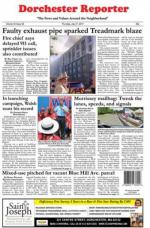July 6, 2023

Boston Home resident Brian Costello, center, with the director of communication Victoria Stevens, left, and activity director Kerry Donahue. Cassidy McNeeley photo
Since the advent of pandemic, residents at the Boston Home, an assisted living facility on Dorchester Ave. at Gallivan Blvd., have struggled to participate in outings because of a lack of wheelchair transportation options. But over the last year, the Home’s activities team has worked with various Dorchester businesses to reconnect its residents to the local community.
“Prior to the pandemic we had a very popular outings program where residents could go to concerts, restaurants, performances, plays, things like that,” said Victoria Stevens, a spokesperson for the Boston Home. “Since the pandemic, transportation for people who use power wheelchairs has become much more challenging.”
Most long-term care facilities stopped doing outings as Covid limitations were put in place, so without a steady demand for transportation, contractors went looking for other work.
The facility, founded in 1881 for adults with advanced multiple sclerosis and other progressive neurological disorders, aims to help its 96 residents, all of whom use manual or motorized wheelchairs, live as independently as possible. They have full access to the building and campus grounds, including bedrooms, a wheelchair enhancement center, a rehabilitation program, and an art gallery.
Also located on campus are the Harmon Apartments, which are affordable, fully accessible settings for disabled adults who are welcomed to participate in activities within the home and in group outings.
While Stevens and staff members hope to see Covid-affected programs resume, there are also looking to set up outings on their own. But without vans, residents are left to rely on their wheelchairs, which are battery-operated and only go a few miles per hour, so any locations they hope to visit must be nearby. Luckily, several local businesses such as the Bowery, Navarra, Bread, Tavolo, and American Provisions, are restaurants that are accessible and welcoming.
Boston Home resident Anne Betschart appreciates the work that these businesses and the activity staff have put into scheduling outings. “They take advance planning and the activity department has made sure that the restaurant can handle the group. These are big wheelchairs, so we need physical space and room to move around the restaurant.”
Even if a restaurant building is wheelchair accessible, that does not necessarily mean it is practical for larger power wheelchairs, said the Home’s Stevens. “A wheelchair might be able to get into that building but can it navigate between the tables? Can you easily pull up and position yourself so that you can reach everything at the table? Are you able to order the food to be brought to you the way you need it?”
She explained that accessibility is also about having servers who can properly position food and drinks for the residents to enjoy. For example, appetizers are served on individual plates so that the residents can reach them without difficulty.
Kerry Donahue, the Boston Home’s activities director, has noticed that visiting these restaurants has had a positive impact on the resident’s mental health. “Their quality of life has just improved, they become more social, and they become more confident,” said Donahue. “Being able to do this just gives them that extra freedom. You go out with friends and socialize; it’s something that we just take for granted.”
Brian Costello is another Boston Home resident who loves to hit the streets of Dorchester. He visits the Dunkin’ at Carney Hospital every Sunday and says that the Lower Mills Tavern “bends over backward just to make sure we’re comfortable.”
While experiences within these restaurants have been great, the travel to and from them in their chairs presents another challenge: the conditions of the sidewalks in Dorchester, many of which are scarred with cracks and divots, and the weather.
When visiting local restaurants, residents work their way down toward the Bowery in Lower Mills or up the avenue to Ashmont Station. “The sidewalks are paved but the tree roots are dislodging them,” said Betschart. “It’s pretty treacherous –‘the mean streets of Dot Ave’ is what we call it.”
Those issues make it difficult for residents to go out on their own without an activity assistant. “It makes it easier if we go,” said Donahue, “because if they need to be repositioned or something happens with their chair, we can help them. It becomes painful if they’re going over those bumps.”
Donahue and Stevens noted that they plan to speak with city lawmakers and ask for fixes to sidewalk conditions.



